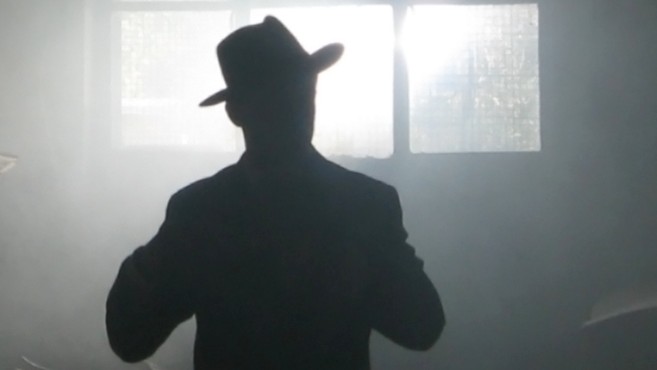Who is the Hat Man? ‘Shadow people’ and sleep paralysis
‘Sleep demons’ have plagued our dreams throughout the centuries, but the explanation could be medical

Most of us have had nightmares involving scary monsters at some point in our lives. But that fear pales in comparison with the seemingly real mysterious and menacing figure who has people around the world shaking in their sheets.
Known as the Hat Man, this tall, dark, featureless character has been seen by people in their bedrooms, watching over them from a doorway, cupboard or corner as they drift between sleep and consciousness. His name comes from the wide-brimmed hat witnesses describe him as wearing.
The figure has recently gained notoriety online, said the Daily Mail. The “mysterious shadowy entity” who has been known to ”haunt people from their bed” also dresses in a “trench coat”, but has no “discernible face or eyes”.
The Week
Escape your echo chamber. Get the facts behind the news, plus analysis from multiple perspectives.

Sign up for The Week's Free Newsletters
From our morning news briefing to a weekly Good News Newsletter, get the best of The Week delivered directly to your inbox.
From our morning news briefing to a weekly Good News Newsletter, get the best of The Week delivered directly to your inbox.
The Hat Man has become so familiar on TikTok that users often reference it as a joke, notably when criticising celebrities’ headwear choices, said Vulture. During Donald Trump’s inauguration, some viewers were distracted by First Lady “Melania’s hat and who the hat made Melania look like”.
Reports of the Hat Man began appearing on social media and online message boards in the late 2000s, attracting widespread attention and inspiring documentaries and the launch of a dedicated blog, The Hatman Project, for people to share their experiences.
Who or what is the Hat Man?
People throughout history have reported seeing a similar “nightmarish figure”, said Quartz, going back to ancient times and inspiring art and myths across all cultures. “People have described a frightening night-time vision that paralyses them with fear and seems to suck the breath right out of them, often by pressing directly upon their chest.”
The phenomenon is known as a “shadow person”, a concept that believers say is a ghost, but scientists attribute to sleep paralysis, when “the brain wakes up before the body does” and the person is unable to move.
A free daily email with the biggest news stories of the day – and the best features from TheWeek.com
“This fashion-forward figure has been reported by so many people that it’s earned its own nickname in sleep paralysis lore,” said IFL Science.
What is sleep paralysis?
This condition occurs when the line between sleep and wakefulness blurs. The sleeper starts to become aware of their surroundings, but is still in a state of temporary paralysis called muscle atonia – the body’s way of stopping us moving and acting out our dreams.
Sleep paralysis episodes tend to last for only a few minutes, but in rare cases can last up to 20 minutes, said the Cleveland Clinic. During an episode, people can feel frozen in place, or experience physical symptoms “like something is pushing you down”, according to the NHS.
Pinpointing the cause of sleep paralysis is tricky. Family history, stress levels, substance abuse and certain mental and physical health conditions appear to correlate with a higher likelihood of experiencing it, according to science magazine Discover. It can also be a side effect of some medications, including “SSRIs, tricyclic antidepressants, anticholinesterase inhibitors, beta blockers, and sleep medications”.
Around 20% of people have an episode of sleep paralysis at least occasionally and of them, as many as 75% suffer hallucinations, according to the Seattle-based Sleep Foundation. These are often informally referred to as “sleep paralysis demons”.
What are sleep paralysis demons?
These “nightmarish hallucinations” often accompany episodes of sleep paralysis, said The Telegraph. One study found 58% of sufferers “sensed a presence in the room, usually something non-human” while 22% claimed they saw a person “usually a stranger”.
“Certain themes tend to occur more often than others,” Chris French, a psychology professor at Goldsmiths, University of London, told the newspaper. In the Middle Ages, sleep paralysis was blamed on “sex-crazed demons” who had their “wicked way with their paralysed, helpless victims”, a belief “beautifully illustrated” in Henri Fuseli’s 1781 painting “The Nightmare”.
Some sufferers have reported “ghosts” or “cat- or alien-like creatures”, with differing levels of threat, said CNN. “Their actions can be as innocuous as simply approaching them or as nefarious as molesting or trying to kill them.”
Others experience a “visitation from an ancestor”, an “eerie, shadowy figure”, as part of a condition classified within parasomnia, characterised by “anxiety, fear, an accurate account of one’s overall surroundings, and an inability to perform voluntary movement in the limb, head, and trunk areas of the body”, said Psychology Today.
This idea is where the term “nightmare” comes from, reported Sleep Foundation. It was originally “night-mare”, referring to a usually female supernatural being that would sit on top of someone’s chest “to suffocate them”.
Experts think we may be able to track trends of sleep paralysis demons through the ages, using popular culture and folklore tales to not only note what people saw, but those stories in turn would dictate what people witnessed, said the Daily Mail. “Witches, hags and incubi” were the most common depictions in the early modern period, mainly because they made up a “key part of folklore” at the time, said Dr Alice Vernon.
“Then in the Victorian era people saw vampires, ghosts and skeletons because of memento mori and funeral culture as well as the growing prevalence of ghost and horror stories.” Nowadays, it is much more common to see “horror-movie-style monsters and villains”.
What does Benadryl have to do with the Hat Man?
For some, the Hat Man is a form of evil demon, sent from the underworld to hurt people. But users on networks like 4chan and Reddit have an alternative, more down-to-earth explanation of why he appears: cough medicine.
The “common denominator” that has “popped up again and again” in the Hat Man saga is taking “diphenhydramine before going to sleep”, said All That’s Interesting. Diphenhydramine is sold over-the-counter as Benadryl, used to treat hay fever and allergies, and is also the main “active ingredient” in several leading brands of cough syrup.
The rumour of a link between DPH and uncanny hallucinations had led some people to post that they were deliberately ingesting large quantities of Benadryl “in hopes of seeing the Hat Man or other shadow people”. This has caused concern among the medical profession, as side effects of excessive DPH consumption include “agitation, confusion, delirium, depression, drowsiness, hallucinations, and seizures”.
Why do people experience sleep demons?
The exact cause of hallucinations like the Hat Man is unknown, but experts believe they “occur when people experience the vivid dreams of REM sleep while they are awake”, reported Sleep Foundation.
Some say the figure of the Hat Man may be the subconscious reworkings of figures from popular culture, including horror films, in recent times. For psychology professor French, “A Nightmare on Elm Street” character Freddy Krueger is the obvious suspect for today’s sightings. He told Quartz: “This notion that you can be attacked when you’re asleep, that’s when you’re vulnerable. And of course, Krueger wears a hat.”
Some research has shown that people who suffer from disorders like anxiety, panic attacks and PTSD may achieve a “hypervigilant state during waking hours, where the body is subconsciously always monitoring for a threat”, said Sleep.com. More research is needed to confirm this link, however.
Can you stop sleep paralysis?
That “remains something of a mystery”, said Discover. There is no single cure for sleep paralysis. Sufferers are advised to focus on breathing and awareness and to “try to initiate movement with a small muscle”, such as a finger or toe, an action that “can help bring an end to the paralysis episode”.
With stress and trauma appearing to be contributing factors, meditation and relaxation can help reduce the chances of being affected. In one study, participants who used these techniques cut the number of episodes they experienced by more than half, and hallucinations by more than one-third.
To minimise the risk of sleep paralysis, a set bedtime routine and at least seven hours of sleep a night are recommended. Sleep paralysis sufferers also report more episodes when they are sleeping on their backs, so sleeping on one’s side could further improve the odds of a peaceful night’s rest, said the New York Post.
-
 In Suriname, the spectre of Dutch slave trade lingers
In Suriname, the spectre of Dutch slave trade lingersUnder the Radar Dutch royal family visit, the first to the South American former colony in nearly 50 years, spotlights role of the Netherlands in transatlantic trade
-
 Political cartoons for December 7
Political cartoons for December 7Cartoons Sunday’s political cartoons include the Trump-tanic, AI Santa, and the search for a moderate Republican
-
 Trump’s poll collapse: can he stop the slide?
Trump’s poll collapse: can he stop the slide?Talking Point President who promised to ease cost-of-living has found that US economic woes can’t be solved ‘via executive fiat’
-
 Femicide: Italy’s newest crime
Femicide: Italy’s newest crimeThe Explainer Landmark law to criminalise murder of a woman as an ‘act of hatred’ or ‘subjugation’ but critics say Italy is still deeply patriarchal
-
 Brazil’s Bolsonaro behind bars after appeals run out
Brazil’s Bolsonaro behind bars after appeals run outSpeed Read He will serve 27 years in prison
-
 Americans traveling abroad face renewed criticism in the Trump era
Americans traveling abroad face renewed criticism in the Trump eraThe Explainer Some of Trump’s behavior has Americans being questioned
-
 Nigeria confused by Trump invasion threat
Nigeria confused by Trump invasion threatSpeed Read Trump has claimed the country is persecuting Christians
-
 Sanae Takaichi: Japan’s Iron Lady set to be the country’s first woman prime minister
Sanae Takaichi: Japan’s Iron Lady set to be the country’s first woman prime ministerIn the Spotlight Takaichi is a member of Japan’s conservative, nationalist Liberal Democratic Party
-
 Russia is ‘helping China’ prepare for an invasion of Taiwan
Russia is ‘helping China’ prepare for an invasion of TaiwanIn the Spotlight Russia is reportedly allowing China access to military training
-
 Interpol arrests hundreds in Africa-wide sextortion crackdown
Interpol arrests hundreds in Africa-wide sextortion crackdownIN THE SPOTLIGHT A series of stings disrupts major cybercrime operations as law enforcement estimates millions in losses from schemes designed to prey on lonely users
-
 China is silently expanding its influence in American cities
China is silently expanding its influence in American citiesUnder the Radar New York City and San Francisco, among others, have reportedly been targeted